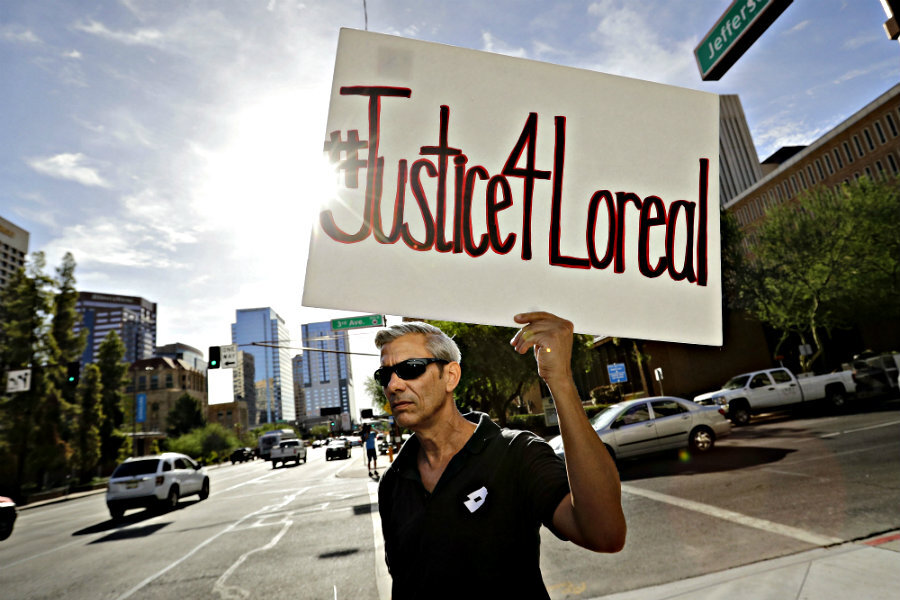The rise of police body cameras: Who's doing it right?
Loading...
As the use of body cameras by police spreads across the United States, adoption of this tool for greater transparency and accountability is only the first step toward credible progress.
A new study of 50 US police departments concludes that even more important than simply using cameras are the rules that govern their use – and particularly who sees the videos produced. Currently, body cameras are liable to be abused due to unclear policies in many jurisdictions, says the study by Upturn, a Washington, D.C., consulting group. But the study also found examples of police departments modeling best practices.
“Body cameras are only a step in the right direction,” Chad Marlow of the American Civil Liberties Union (ACLU) tells The Christian Science Monitor by phone, “if their use is governed by principles.”
Body cameras have long received praise for the transparency they can bring, not only to sometimes murky investigations of police conduct but day-to-day interactions with the public. A March, 2015, interim report by the President’s Task Force on 21st Century Policing also found that officers wearing cameras reported 87.5 percent fewer incidents of force, and 59 percent fewer complaints than officers not wearing cameras.
Proponents of body cameras say that they can protect both police and civilians.
“Body-worn cameras hold tremendous promise for enhancing transparency, promoting accountability, and advancing public safety for law enforcement officers and the communities they serve,” said Attorney General Loretta Lynch last spring while announcing $23.2 million in grants by the Justice Department that could aid smaller police departments in obtaining body cameras.
Last October, the Monitor reported that four Cleveland police officers' jobs were saved by the body cameras they were wearing at the time of an incident in which gunfire was exchanged between officers and an armed suspect.
Yet, despite their many proponents, body-worn cameras also have been criticized by civil rights groups due to concerns about privacy, footage review, and public viewing policies.
If the public can’t gain access to the footage, critics say, then little will change regarding police accountability, MSN reports. "Body cameras carry the promise of officer accountability, but accountability is far from automatic," Harlan Yu, the study co-author, said on a conference call with reporters.
And in the many jurisdictions where officers can view footage prior to writing up a report on a given incident, that footage can inform officers' accounts of an event in such a way that could be detrimental to civilians when they testify in court. According to Mr. Marlow, allowing officers to view body camera videos of an incident before they write their initial report, while preventing the civilians involved from seeing those videos, can naturally give officers an edge in judicial proceedings by allowing them to shape their story to the available evidence.
Last month, civil rights advocates criticized a newly signed North Carolina law that prevents police dashboard and body camera footage from being considered public record, a policy that they say can promote injustice.
“There’s a real fear among many civil rights advocates and communities that body-worn cameras will become just another tool for surveillance,” Mr. Yu tells the Monitor by phone.
A number of police departments have pushed back against the criteria for body camera policies outlined in the study, says Dr. Yu, including Fresno, Calif., a city which failed every one of the eight categories outlined in the report. Fresno Police Chief Jerry Dyer called the report “flawed,” and criticized authors for not involving police departments more.
But beyond Fresno, many others have responded positively to their scorecard results, often by publishing their body camera policies online to make them more available to the community. Chicago and Cincinnati scored relatively well.
One of the top scores went to Parker, Colo., a community that has done a good job of balancing the interests of both police and civilians. The city of nearly 50,000 people first considered implementing a body camera policy in 2012.
“The Chief of Police saw that body worn cameras were the way that policing was going to go,” says Parker Police Department public relations coordinator Josh Hans.
The police department worked together with officers and the ACLU for years to refine and develop a policy that has, according to Mr. Hans, seen success since its implementation in the fall of 2015.
The policy has been so successful, in fact, that it was the only police department studied in Upturn’s report that received no failing grades in any category, with just three of eight categories receiving “partially satisfactory” ratings.
“Trust is built through transparency,” says Hans, “and there’s no better way to show the public what is going on than by using body cameras.”
The biggest step that the Parker Police Department made, according to Hans, was reaching out to the ACLU after the Parker chief of police decided that body cameras would be adopted his law enforcement officers. Discussing the policy with subject matter experts at the ACLU, as well as with police officers, helped Parker officials to draft a comprehensive and balanced policy.
While many police officers resisted the policy at first, the officer buy-in to the program has been so great that Hans says officers no longer want to go out on the streets without cameras.
“Everyone behaves better when they know they’re being recorded,” says Hans. “And that’s the goal.”






